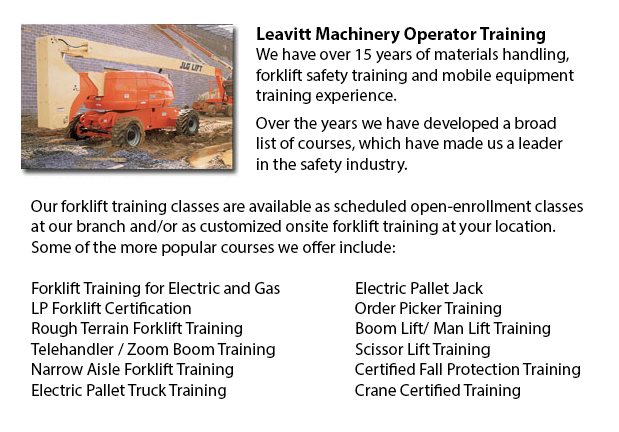
Aerial Boom Lift Training Richmond Hill - Aerial Boom Lift Training is needed for anybody who operates, supervises or works in the vicinity of boom lifts. This type of aerial lift or aerial work platform is used for lifting people, materials and tools in projects requiring a long reach. They are generally used to access utility lines and other above ground job-sites. There are various types of aerial booms lifts, like cherry pickers, articulating boom lifts and extension boom lifts. There are two kinds of boom lift: "knuckle" and "telescopic".
Boom lift training is important and typically involves the basic operations, equipment and safety matters. Employees are required whilst working with mobile machinery to understand the dangers, safe work practices and rules. Training program materials offer an introduction to the terms, uses, skills and concepts required for workers to gain competence in boom lift operation. The material is aimed at safety experts, workers and machine operators.
For your company requirements, this training is adaptive, cost-effective and educational and would help your workplace become more effective and safer, allowing for higher levels of production. Fewer workplace incidents take place in workplaces with strict safety policies. All machine operators must be trained and evaluated. They require understanding of present safety measures. They must understand and adhere to guidelines set forth by their employer and local governing authorities.
Employers should make sure that their workers who operate aerial boom lifts get proper training in their safe use. Operator certification is needed on each different type of aerial machine used in the workplace. Certifications are available for articulating booms, aerial work platforms, scissor lifts, industrial forklift trucks, and so on. Fully trained workers work more efficiently and effectively compared to untrained workers, who require more supervision. Right instruction and training saves resources in the long run.
Training is the best prevention for the primary reasons for workplace fatalities: falls, electrocutions and collapses or tip overs. Aside from training, the best way to avoid workplace accidents is to maintain and operate aerial work platforms based on the instructions of the manufacturer. Allow for the combined weight of the materials, worker and tools when following load limitations. Never override mechanical, electrical or hydraulic safety devices. Workers should be held securely in the basket with a restraining belt or body harness with a lanyard attached. Do not move lift equipment when employees are on the elevated platform. Employees should be careful not to position themselves between the basket rails and joists or beams in order to prevent being crushed. Energized overhead power lines must be at least 10 feet away from the lift equipment. It is suggested that workers always assume power lines and wires might be energized, even if they seem to be insulated or are down. Set the brakes and utilize wheel chocks if working on an incline.
-
Scissor Lift Certification Richmond Hill
Scissor Lift Certification Richmond Hill - Scissor lift platforms are utilized at work sites in order to allow tradespeople - like for example welders, masons and iron workers - to reach their work. Operating a scissor lift platform is usually second... More -
Narrow Aisle Forklift / Order Picker Training / Electric Pallet Jack / Electric Pallet Truck Training in Richmond Hill
A pallet jack is a model of equipment specialized in the transporting of pallets of many dimensions and weights. They might be utilized as an appendage for lift trucks, cranes and other types of heavy machinery or be used on their own. Pallet jacks a... More -
Heavy Equipment Operator Certification Richmond Hill
Heavy Equipment Operator Certification Richmond Hill - The heavy equipment operator is a person who manipulates the controls and drives various kinds of big machinery. Heavy machinery is most frequently used on construction sites in order to deliver... More -
Loader Training Richmond Hill
Loader Training Richmond Hill - Why You Must Finish A Loader Training Course - Individuals wanting work in businesses that use lift trucks must undergo a Loader Training program prior to becoming a certified operator of a lift truck. There are lots o... More -
Manlift Training Richmond Hill
Manlift Training Richmond Hill - Various manlift training programs consist of the review and content of manlift devices. An important part of the course is the practicum where students show their knowledge and practical ability to safely operate a ma... More -
Fall Protection Training in Richmond Hill
There are many injuries at work associated to falling and a lot of fall-related deaths reported every year. Most of these instances could have been prevented with better training, better measures in place, and by correctly equipping personnel before... More -
Wheel Loader Training Richmond Hill
Wheel Loader Training Richmond Hill - Commonly, the various kinds of heavy equipment training are classed into 2 categories of machinery: those which have rubber tires and tracked vehicles. Tracked vehicles consist of items like cranes, bulldozers an... More -
Forklift Certification Schools Richmond Hill
Forklift Certification Schools Richmond Hill - Forklift Certification is mandatory in North America. Hence, forklift training programs are important both for companies and for people seeking jobs in industries as forklift operators. Forklift training... More

Forklift Training Richmond Hill
TOLL FREE: 1-888-254-6157
Richmond Hill, Ontario
forklifttrainingrichmondhill.com
Email Us
About Us


